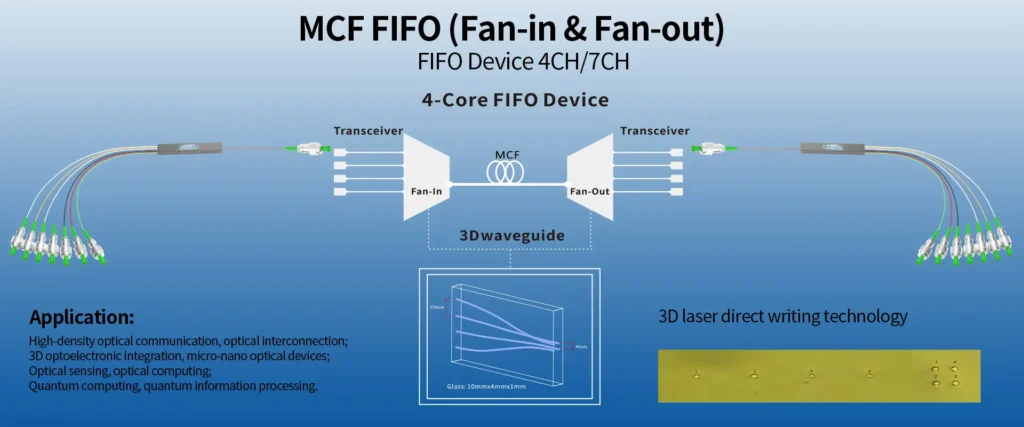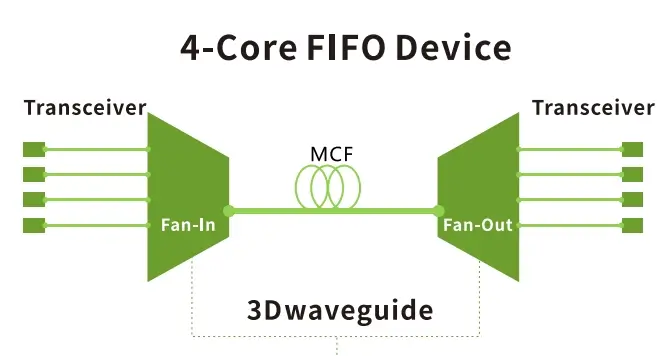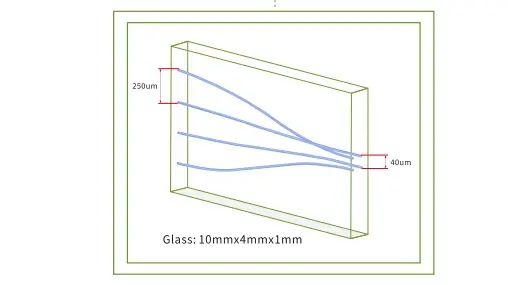4-Core Fan-In/Fan-Out Devices: A Practical Guide for Multi-Core Fiber Systems
As the global demand for data transmission continues to surge, multi-core fiber (MCF) has emerged as a transformative solution to overcome the limitations of traditional single-core optical fibers. By integrating multiple optical paths—known as cores—within a single cladding, multi-core fiber enables space-division multiplexing (SDM) to dramatically boost bandwidth capacity without requiring more fiber infrastructure.
Among the essential components for deploying MCF systems are fan-in/fan-out devices, particularly the 4-core fan-in/fan-out module. These devices play a critical role in coupling multi-core fibers with standard single-mode fiber (SMF) networks, ensuring backward compatibility and streamlined integration into existing optical infrastructures.
In this practical guide, we’ll explore:
What 4-core fan-in/fan-out devices are
Their technical specifications and performance metrics
Key application scenarios in real-world networks
Market availability and example product options
Considerations when choosing a reliable solution

What Is a 4-Core Fan-In/Fan-Out Device?
A 4-core fan-in/fan-out device is an optical coupling component that allows four individual single-mode fibers to interface with the four separate cores of a 4-core multi-core fiber. It operates in two directions:
Fan-In Mode: Combines signals from four single-mode fibers into a 4-core MCF.
Fan-Out Mode: Splits the signals from a 4-core MCF into four separate SMFs.
These modules ensure low insertion loss, minimal crosstalk, and accurate core alignment, allowing multi-core fiber systems to communicate effectively with standard network hardware.
Structural Features:
Precision-aligned core mapping for consistent signal routing
Connectorized outputs (LC, SC, FC, MPO) for plug-and-play deployment
Compact form factor, ideal for high-density data center and backbone deployments
Technical Specifications
To ensure optimal performance, 4-core fan-in/fan-out devices must meet precise optical standards. Here are the common specifications:
| Specification | Typical Values |
|---|---|
| Insertion Loss | 0.5 – 1.0 dB per channel |
| Return Loss | ≥ 50 dB |
| Crosstalk Isolation | ≥ 45 dB |
| Core Spacing (Pitch) | 35 – 50 µm (depending on fiber design) |
| Fiber Type Compatibility | 125 µm cladding 4-core MCF and SMF-28 compliant single-mode fiber |
| Wavelength Range | O-band (1310 nm), C/L-band (1550 nm) |
| Operating Temperature | 0°C to +85°C |
| Connector Options | LC/PC, SC/APC, FC/UPC, MPO/APC (customer configurable) |
Precision manufacturing is vital to ensure core-to-core alignment accuracy, especially in high-speed systems where even slight misalignments can increase insertion loss or crosstalk.
Why Use a 4-Core Fan-In/Fan-Out Device?
The shift from single-core to multi-core fiber isn’t just about increasing bandwidth—it’s about future-proofing network infrastructures. A 4-core fan-in/fan-out module supports this shift by offering the following benefits:
1. Backwards Compatibility
It allows multi-core fibers to interface with standard single-mode fiber networks, avoiding the need to replace legacy systems.
2. Scalable High-Capacity Links
A single 4-core MCF link can handle four simultaneous data streams, quadrupling the bandwidth compared to a single-core fiber—perfect for metro, backbone, and inter-data-center connections.
3. Space and Cost Savings
Using one 4-core MCF instead of four separate fibers reduces cable volume, conduit space, and installation complexity, resulting in lower deployment costs and higher port efficiency.
4. Low Crosstalk for Clean Transmission
High-quality fan-out modules ensure crosstalk isolation above 45 dB, essential for data integrity in dense communication environments like data centers.
Applications of 4-Core Fan-In/Fan-Out Devices :
| Application | Benefit |
|---|---|
| SDM Long-Haul Networks | Expands transmission capacity by a factor of four per fiber. |
| Data Center Interconnects | Supports high-throughput, low-latency multi-lane connections. |
| Metro and Subsea Networks | Ideal for space-constrained environments requiring high-capacity links. |
| Distributed Sensing Systems | Enables parallel measurements in sensing arrays for temperature or strain. |
| Research and Development | Suitable for optical system prototyping, QKD experiments, and SDM trials. |
One major advantage of 4-core MCF systems is that they support diverse wavelength bands and can be used for both digital communications and sensing applications, including fiber shape sensors and quantum key distribution (QKD) systems.


Market Availability and Product Examples
Several leading manufacturers offer commercial 4-core fan-in/fan-out solutions:
1. Fibercore (UK)
Product: FAN-4C
Key Specs: ~1 dB insertion loss, ≥45 dB crosstalk isolation
Options: LC/PC, SC/APC, FC/UPC, and MPO/APC connectors
Use Case: Designed for optical labs, R&D, and telecom prototyping
2. Fibrecross(China)
Product Category: Multi-Core Fiber Coupling Connectors
Positioning: Tailored for data centers and submarine fiber deployments, Fibrecross provides reliable OEM fan-in/out solutions built with tight alignment and customizable pigtails.
3. Chiral Photonics (USA)
Custom solutions with low insertion loss and customer-selected connectors
Use Case: Deployed in both commercial and defense research environments
How to Choose the Right Fan-In/Fan-Out Device
When selecting a 4-core fan-in/fan-out module, consider the following:
Insertion and Return Loss: Look for <1 dB insertion loss and ≥50 dB return loss for optimal signal quality
Connector Type: Ensure compatibility with your patch panels or test setups
Environmental Tolerance: Verify temperature and humidity operating ranges
Core Alignment Precision: Sub-micron alignment ensures low crosstalk and high signal fidelity
Customization Needs: For specific applications, choose vendors offering customizable connector and fiber types
If you’re looking for flexibility and long-term scalability, opt for solutions that are modular and field-upgradable, especially in dynamic environments like hyperscale data centers.
Final Thoughts
As the industry shifts toward ultra-high-capacity transmission systems, 4-core fan-in/fan-out devices are becoming indispensable components of multi-core fiber networks. Whether used for long-haul SDM backbones, inter-data-center links, or advanced fiber sensing applications, these modules ensure seamless integration and performance.
Vendors like Fibercore, HYC, Chiral Photonics, and Fibrecross are at the forefront of this transformation, offering innovative products with high precision and low signal loss. By choosing the right fan-in/out device, engineers and researchers can future-proof their optical infrastructure, reduce complexity, and unlock the full potential of space-division multiplexing.
FAQs About 4C Multicore Fiber MCF FIFO
A 4-core fan-in/fan-out device enables the coupling of standard single-mode fibers (SMF) to each of the four cores within a multi-core fiber (MCF). This allows seamless integration of next-generation MCF systems with existing optical infrastructure, supporting both legacy and high-capacity SDM networks.
The most important specifications include low insertion loss (typically <1 dB), high return loss (≥50 dB), and excellent crosstalk isolation (≥45 dB). Core alignment accuracy, connector type compatibility, and environmental tolerance are also critical for long-term network reliability.
These devices are widely used in high-capacity backbone networks, inter-data-center connections, metro fiber systems, and advanced optical sensing applications. They’re also essential in research environments for quantum communication, SDM testing, and fiber shape sensing.
No. The device must match the core geometry and spacing of the specific multi-core fiber type. Most commercial 4-core devices are designed for square or linear core arrangements with a core pitch of 35–50 μm. Always confirm compatibility with your fiber specifications before purchase.

